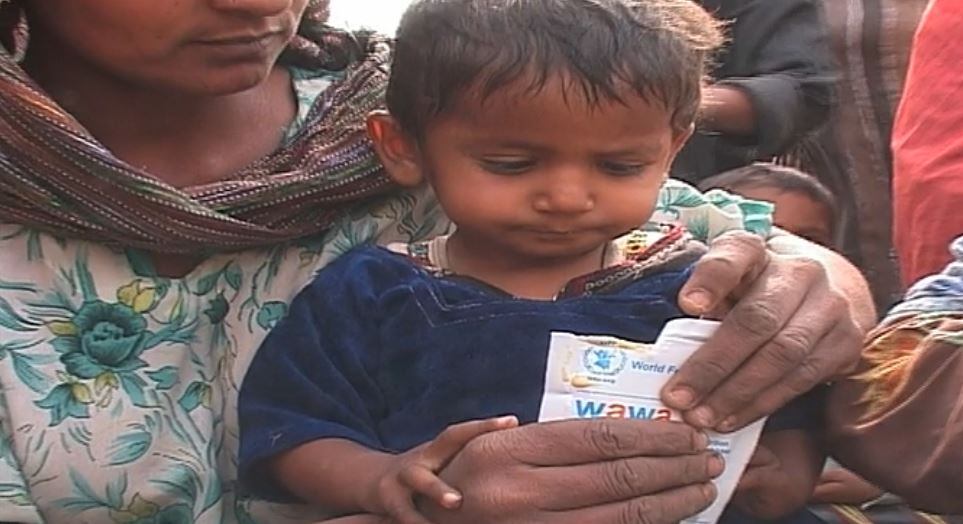Wawamum is a nutrition product designed by the United Nations’ World Food Programme (WFP), to protect children in Pakistan from malnutrition.
It is a locally produced lipid-based nutrient supplement containing roasted chickpeas, vegetable oil, dry skimmed milk powder, sugar, micronutrients, emulsifier and antioxidants, which can be consumed without the need for water or cooking.
In this study, childrenaged between six to 23 months of age were given a daily supplementation (50g) of Wawamum, which was said to cover the RDA of most micronutrients, and about one-quarter of their daily energy requirements (255kcal).
Stunting is a major public health problem in Pakistan, with 38% of children stunted and 17% severely stunted. Stunted children have a higher risk of mortality, lower academic achievements, low economic productivity, reduced cognition, and higher risk of morbidities in adulthood.
Researchers from the Aga Khan University, and World Food Programme published the findings in the PLOS ONE journal.
Study design
This study is part of a cluster randomised controlled trial (RCT) conducted from 2014 to 2016 in the Thatta and Sujawal districts of Sindh, Pakistan. The first cohort consisted of pregnant and lactating women, who received wheat soya blend during pregnancy and lactation.
The second cohort consisted of children aged 6 to 23 months who received Wawamum while the third cohort of children (24 to 59 months) received micronutrient powders.
This current study only presented the results of the second cohort.
A total of 870 (419 in intervention; 451 in control) children between 6 to 18 months old were enrolled in the study.
The intervention group received 50g of Wawamum sachet daily, alongside standard government health services, while the control group only received standard health services, mainly health and hygiene education.
The primary outcome was stunting, and second outcomes were wasting and underweight. The children were followed up for at least six months, or until they reached 24 months of age.
On average, each child consumed Wawamum for 266.9 ± 123.1 days (between 4 to 8 months).
It was interesting to note that Wawamum was also shared among family members during the study. Only 3.9% of children did not share their Wawamum sachets.
Wawamum helps lower risk of stunting and wasting
Overall, there was a significant lower risk of stunting (p<0.001) and wasting (p=0.004) in the intervention group, compared to the control group.
In addition, children who received Wawamum had a significant reduction in anaemia (p=0.042). compared to children who only received the standard government health services. However, 91% of children in the intervention group were still anaemic at the end of the intervention, despite the daily supplementation. Researchers attributed this to the low compliance of around 60%.
There was no significant reduction in the risk of underweight.
Researchers acknowledged that their study was limited by the fact that most children shared Wawamum with their family members, which would have reduced the impact on the nutritional status of the children.
The study confirmed that the supplementation of Wawamum to children 6 to 23 months of age was effective in reducing the risk of stunting, wasting and anaemia.
“This approach should be scaled up among the most food insecure areas/households with a high prevalence of stunting to achieve positive outcomes for nutrition and health,” researchers added.
They also advised that a longer period of supplementation had potentially greater impact on reducing the risk of stunting.
Lipid-based nutrient supplements such as Wawamum are used extensively in vulnerable populations.
For example in China, a locally produced soybean-based supplement (Ying Yang Bao) given to children 6 to 18 months of age was also found to decrease stunting from 8.9% to 1.7% and wasting from 3.5% to 1.7%. A Bangladesh-based company Frontier Nutrition is also producing its lentil butter and fortified snacks to fight malnutrition.
Source: PLOS ONE
https://doi.org/10.1371/journal.pone.0237210
“Effect of lipid-based nutrient supplement—Medium quantity on reduction of stunting in children 6-23 months of age in Sindh, Pakistan: A cluster randomized controlled trial”
Authors: Gul Nawaz Khan, et al.




